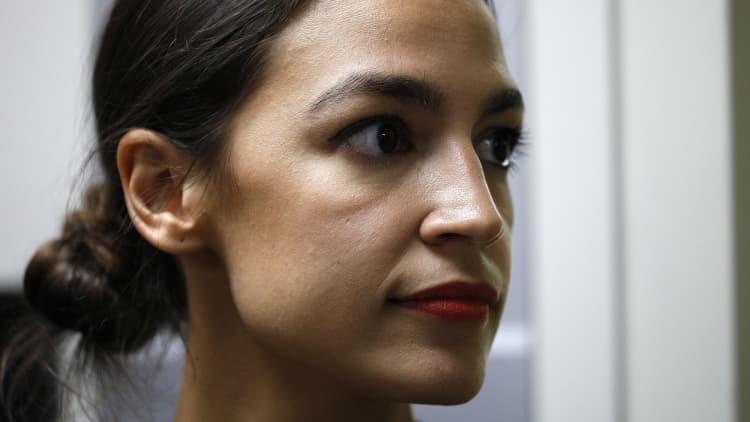
The tax furor triggered by Rep. Alexandria Ocasio-Cortez has opened debate on a core question for all Democrats: Where should government get more money?
Virtually none doubt the need for new revenue. Aside from new programs the party favors, the federal budget deficit is already projected to top $1 trillion in 2019 and keep rising for years.
Ocasio-Cortez, the 29-year-old Democratic firebrand who just took her seat to represent the Bronx in the House, has sparked headlines by suggesting rates as high as 70 percent to finance a "Green New Deal." That drew swift derision from House GOP Whip Steve Scalise, who summarized it as "Take away 70 percent of your income and give it to leftist fantasy programs."
In fact, Ocasio-Cortez didn't propose taking 70 percent of anyone's income. She suggested applying the rate only to earnings beyond $10 million, meaning those affected would pay a much lower share of their income overall.
The top tax rate stood above 90 percent throughout the 1950s. But through deductions and tax avoidance, "taxes on the rich were not that much higher" then, the conservative Tax Foundation noted in a 2017 article.
The top rate remained 70 percent as late as 1981, the first year of Ronald Reagan's presidency. The most affluent 1 percent paid a far lower average rate of 30.5 percent, however, according to a Tax Policy Center analysis. By 1989, when Reagan left office, the top rate had been slashed to 28 percent but their average rate dropped only slightly to 27.9 percent.
After three decades with top rates below 40 percent, a big hike from today's 37 percent poses risks politically and perhaps economically. Self-described socialist Sen. Bernie Sanders stopped at a 54.2 percent for incomes above $10 million in his 2016 presidential campaign proposal; Democratic nominee Hillary Clinton proposed 43.6 percent for those earning above $5 million.
With little prospect of success under President Donald Trump, the new House Democratic majority has avoided the issue in its initial legislative agenda. But the party's gathering field of 2020 presidential candidates won't have that luxury.
The only formally declared Democratic candidate, former Rep. John Delaney of Maryland, wants to finance infrastructure projects by raising the recently enacted 21 percent top corporate rate to 25 percent. Sen. Kamala Harris of California has proposed curbing income inequality by rolling back all the Trump tax cuts in favor of expanded tax credits for modest earners.
"You've got to ask, 'What constitutes a fair share in this economy?'" Massachusetts Sen. Elizabeth Warren told me in a recent Speakeasy interview. She conceded that 1950s-era rates "sound pretty shockingly high," but declined to specify what she favors.
Betsey Stevenson, a former economic adviser to President Barack Obama, favors other targets: eliminating the "step-up" valuation that lets some inherited assets avoid capital gains taxes, and capping tax deductions for the wealthy. Those two combined would raise more than the $700 billion over 10 years that Ocasio-Cortez's idea would and, she argues, make better economic sense.
"Finding new revenue is exactly where Democrats should be," Stevenson explained. But a big top-rate hike "would not be the first thing I would do, it would be the last thing."
How much revenue Democrats need depends on what new programs they ultimately pursue. Analysts have priced Sanders' "Medicare for All" plan at $32 trillion; Sen. Sherrod Brown backs a far less expensive Medicare "buy-in" for 55 and over.
Republican resistance casts doubts on prospects for new taxes in any event. Former Fed chairman Alan Greenspan, for example, warns a 70 percent top income tax rate would prove a "terrible mistake" by dampening economic activity.
As the party of limited government, the GOP opposes most new programs however they're paid for. As deficits balloon following their tax cuts, GOP leaders suggest curbing the massive Social Security and Medicare programs.
But the demographic tidal wave of baby boomer retirements will swamp any politically feasible "entitlement reform." The 2019 deficit will exceed the entire Medicare budget, and the government projects the number of Americans 65 and older will jump 50 percent to 77 million in 15 years.
That's why Douglas Holtz-Eakin, who advised President George W. Bush, agrees that governments led by either party will eventually need more revenue. He prefers taxing consumption instead of income on economic grounds, though any new taxes will strain America's polarized political system.
"We will need all the economic growth we can get, we need to control spending, and we need to raise revenue," Holtz-Eakin said, recounting advice he recently gave House Republicans. "It's going to be ugly."


